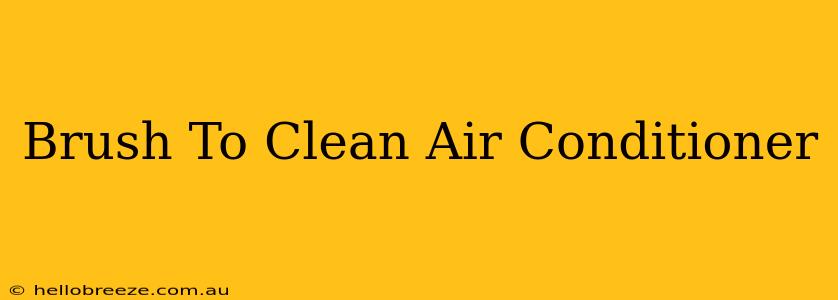Is your air conditioner blowing out warm air? Is it making strange noises? It might be time for a deep clean, and a simple brush can be your best friend! This comprehensive guide will walk you through how to effectively use a brush to clean your air conditioner, ensuring optimal performance and a healthier home environment. We'll cover everything from the types of brushes to use to safety precautions and maintenance tips.
Why Clean Your Air Conditioner with a Brush?
A dirty air conditioner works harder, uses more energy, and is less effective at cooling your home. Dust, dirt, leaves, and other debris accumulate on the condenser coils (the outside unit) and the evaporator coils (the inside unit), restricting airflow and reducing efficiency. Using a brush is a cost-effective and efficient way to remove this build-up, preventing more serious problems down the line.
Benefits of Brushing Your AC:
- Improved Cooling Efficiency: Clean coils allow for better heat transfer, leading to improved cooling performance.
- Reduced Energy Consumption: A clean AC unit doesn't have to work as hard, saving you money on your energy bills.
- Extended Lifespan: Regular cleaning helps prevent premature wear and tear, extending the life of your air conditioner.
- Improved Indoor Air Quality: Removing dust and debris reduces allergens and pollutants circulating in your home.
- Prevent Costly Repairs: Addressing minor issues early, like dust build-up, can prevent more expensive repairs later.
Types of Brushes for Air Conditioner Cleaning
Not all brushes are created equal. The best brush for cleaning your air conditioner depends on the specific area you're cleaning and the type of debris you're removing. Here's a breakdown:
1. Soft-Bristled Brushes: Ideal for delicate areas like the fins of the evaporator coils (inside unit). Avoid stiff bristles that could damage the fins. A long-handled brush is extremely helpful for reaching hard-to-access areas.
2. Stiff-Bristled Brushes: Better suited for the condenser coils (outside unit) where you're tackling tougher dirt, leaves, and other debris. Make sure the bristles are durable enough to effectively remove build-up without bending or breaking.
3. Coil Cleaning Brush: Specifically designed for cleaning air conditioner coils. These brushes often feature a flexible head that conforms to the shape of the coils, making cleaning more thorough and efficient.
Step-by-Step Guide to Cleaning Your Air Conditioner with a Brush
Before you begin: Always disconnect the power to your air conditioner before cleaning. This is a crucial safety precaution to prevent electric shock.
1. Prepare Your Workspace: Gather your cleaning supplies, including your chosen brush(es), a vacuum cleaner with a hose attachment, and a garden hose (for the outdoor unit). Wear appropriate safety gear, including gloves and eye protection.
2. Clean the Outdoor Unit (Condenser Coils): Carefully remove any large debris such as leaves and twigs. Use the stiff-bristled brush to gently but firmly brush away dirt and dust from the condenser coils. Once brushed, use a garden hose to rinse away any loose debris. Allow the unit to completely dry before reconnecting the power.
3. Clean the Indoor Unit (Evaporator Coils): Use the soft-bristled brush to gently clean the evaporator coils. Pay close attention to any areas with significant dust accumulation. Use the vacuum cleaner's hose attachment to suck up any loose debris.
4. Final Touches: After cleaning both units, inspect the area for any remaining debris. Ensure that all components are clean and dry before restoring power.
Maintaining a Clean Air Conditioner
Regular brushing is key to maintaining a clean and efficient air conditioner. Aim to clean both the indoor and outdoor units at least once a year, or more frequently if you live in a dusty or high-pollutant area. By following these steps, you can keep your air conditioner running smoothly and efficiently, saving you money and enjoying cool comfort all season long.
Frequently Asked Questions (FAQs)
Q: Can I use a pressure washer to clean my air conditioner?
A: No, a pressure washer can damage the delicate fins of your air conditioner. Use a garden hose with gentle pressure instead.
Q: How often should I clean my air conditioner?
A: At least once a year, or more frequently if needed.
By following this guide and incorporating regular cleaning into your home maintenance routine, you can ensure your air conditioner remains in top shape for years to come. Remember, a little effort can go a long way in ensuring optimal performance and a healthier home environment!

